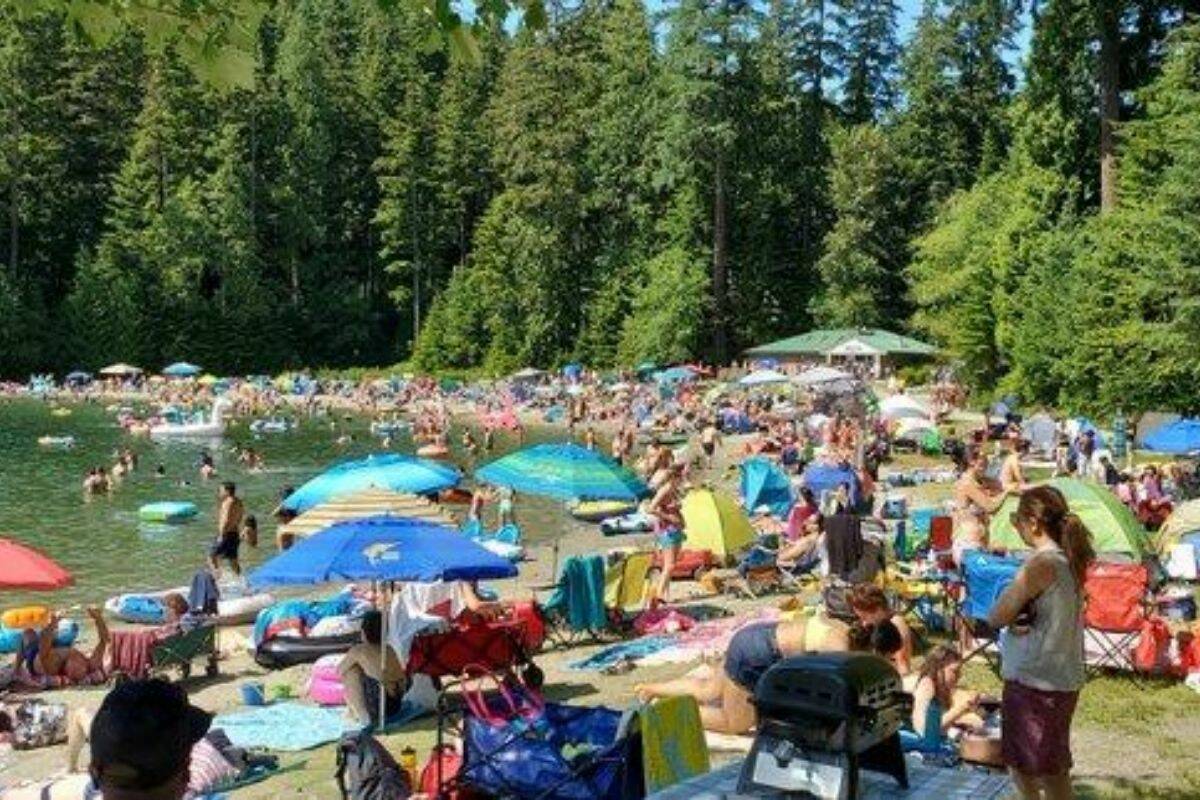By Patrick Penner, Local Journalism Initiative Reporter
Imperial Oil’s dam on the northwest corner of Sasamat Lake has been in place for a century, but the company says it’s considering its removal.
The decision could have wide-ranging effects on the lake.
“We really don’t have a need for the dam anymore,” said Ali Tejpar, project manager of the Sasamat Lake Dam Project.
Imperial Oil sent a delegation to Port Moody council on Jan. 10, presenting two possible options for the future of the site: decommissioning, or replacing the dam.
Sasamat Lake Dam was originally installed approximately 100 years ago to draw water for operations at the refinery on Ioco Road in the Port Moody Arm.
The lake had since grown into a popular recreational area for the region, containing White Pine Beach, the Sasamat Outdoors Centre, a pedestrian floating bridge and walking trails.
The dam was replaced in the 1960s. However, since the Ioco refinery was converted into a terminal in 1995, the company’s operational usage of the dam has lessened considerably.
In August 2019, the Ministry of Forest, Lands and Natural Resource Operations conducted an inspection of the dam and observed seepage. They ordered Imperial Oil to create a plan to address the issue.
The company first thought they could repair the dam, according to Tejpar, but a review by a consultant showed repairs would only result in a temporary fix to long-term safety and reliability issues.
Since March 2021, Imperial Oil has come up with two options, and is consulting with stakeholders and local First Nations to hear further concerns.
It has contracted Stantec, an engineering company, to conduct a series of environmental impact studies for both options. Further geotechnical exploration is slated to begin in February.
Tejpar said their primary responsibility is to ensure that the dam is “adequately maintained and safe.”
Options
Option one is to replace the dam, which would have little to no effect on the current topography of the lake.
A replacement dam would be designed in a “like-for-like approach,” with a similar structure being installed under modern engineering specifications and regulations.
There would be almost no change to the existing water levels, and limited impacts to the vegetation, wildlife, and fish habitats only in the immediate area of the dam footprint, according to Joel Pineu, a geotechnical engineer with Stantec.
He added that some of these impacts could be easily mitigated during construction.
Option two would be decommissioning the dam – Imperial’s preferred option, according to Tejpar.
This would involve the complete removal of the existing dam down to the bedrock surface, lowering the water level of Sasamat Lake by around two metres.
Pineu said there would be some long-term changes and residual effects to the wetlands and riparian vegetation, though it’s not expected to impact local wildlife permanently.
There would also be some temporary impacts to fish habitat and fish productivity, as it would reduce shallow water areas until new wetlands could form, he added.
Sasamat Lake naturally flows into Windemere Creek in Belcarra, and environmental impact and flood-routing studies were conducted to examine what would happen if the dam were removed.
Pineu said the creek has limited fish habitat, and there would be minimal differences between replacement and decommissioning options.
He said they don’t expect any impact to Belcarra residences or local bridges should a one-in-100-year flood occur in a “rainfall-only” scenario.
In either design option, Imperial Oil would include a pedestrian bridge to cross the lake, Tejpar said.
Council comments
The Imperial Oil representatives were asked by Coun. Kyla Knowles about what other stakeholders it had engaged with to this point, and what feedback they’ve received.
Lesley Cabbot, engagement specialist with Stantec, said they have been in contact with Metro Vancouver, the villages of Belcarra and Anmore, and First Nations in the area (with Tsleil-Waututh Nation taking the lead), and the Sasamat Outdoors Centre.
Tejpar said there was too much feedback to go over during this presentation, but admitted that most concerns were voiced over the decommissioning option.
Coun. Callan Morrison stated the preferred option for the public would be to have little to no impact to the beaches or wildlife.
Tejpar responded they are trying to make a “fact and data driven” decision, and are trying to understand the scope of concerns. At this point, however, the company does not plan on conducting any engagement with the general public.
Mayor Meghan Lahti advised the company to consider engaging with the people who use the Sasamat Lake facilities.
Coun. Haven Lurbiecki agreed, calling further engagement “absolutely critical” and describing the area as a recreational asset for the entire region.
The company’s flood modelling for Windemere Creek was questioned by Coun. Amy Lubik. She asked if there were any more extreme models beyond a “rain only” scenario where the flooding would occur if the dam was removed.
Pineu said they based their studies off the Village of Belcarra’s 1-in-100-year flood modelling, and the only events that resulted in some flooding were heavy rainfall on top of snowmelt.
Lubik pointed out that the climate is rapidly changing, bringing up the recent atmospheric river events in B.C., and questioned whether Belcarra’s modelling was sufficient.
READ ALSO: A whistle, a watch and DNA identify B.C. soldier 106 years after death in France

